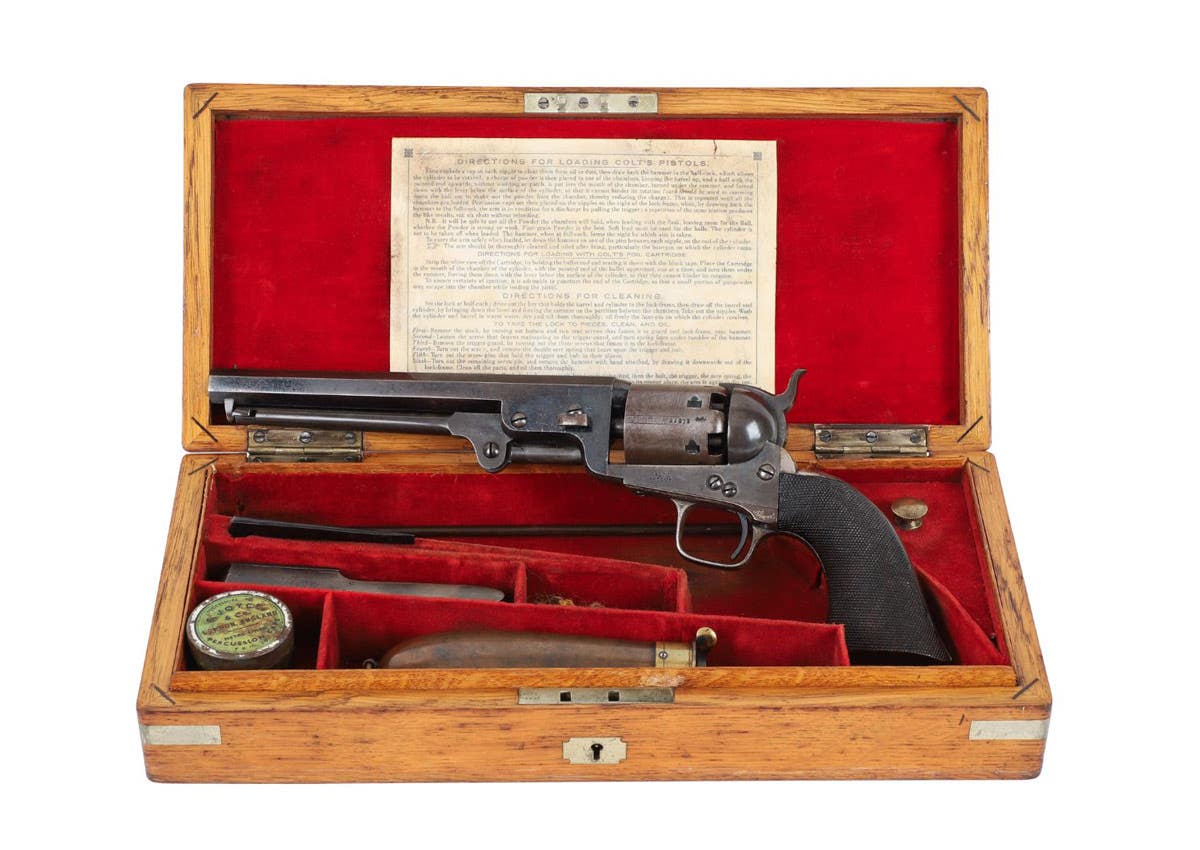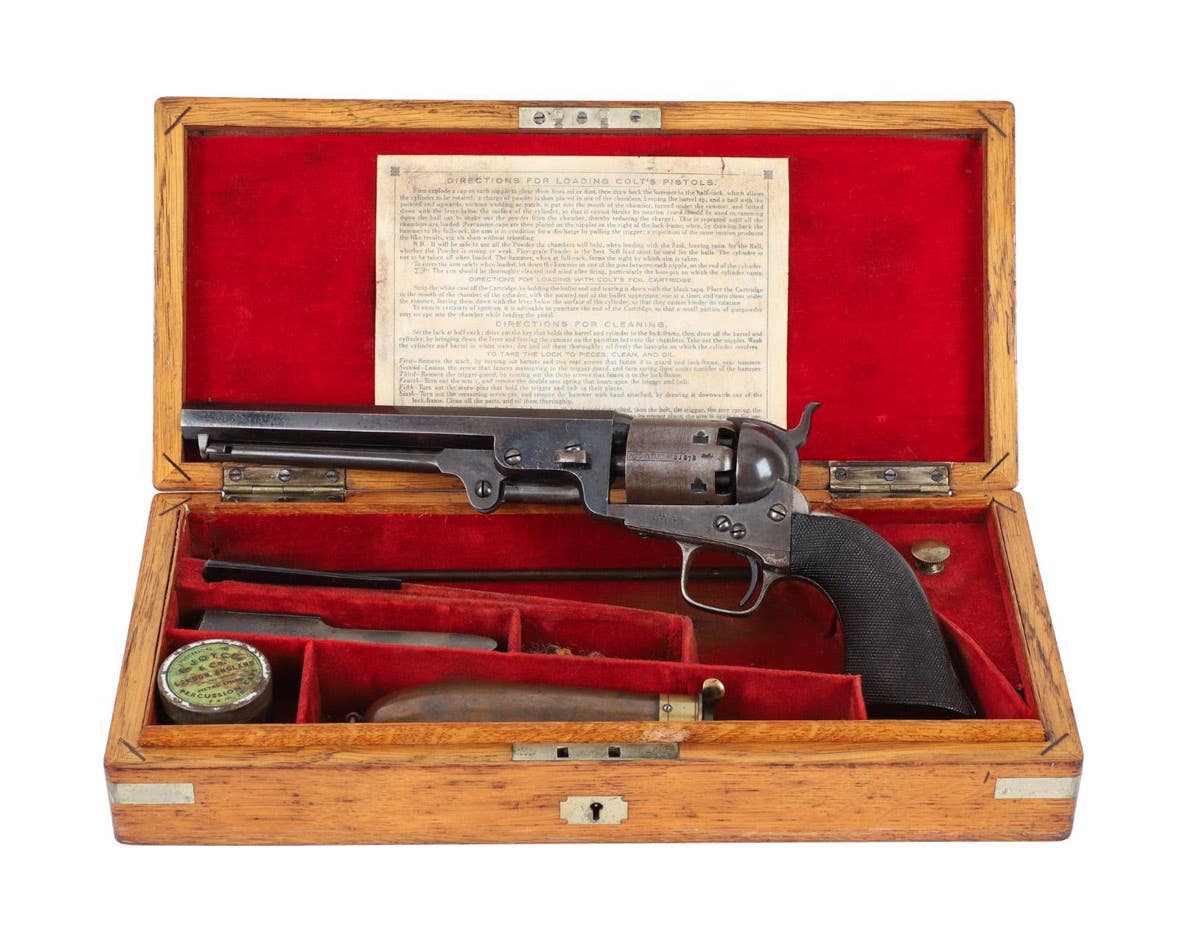Hermann Historica’s Spring Auction Recap
Munich – This year’s Spring Auction at Hermann Historica GmbH took place May 1-11. Approximately 6,500 lots from all specialist areas represented by the auction house came under the hammer…
Munich – This year's Spring Auction at Hermann Historica GmbH took place May 1-11. Approximately 6,500 lots from all specialist areas represented by the auction house came under the hammer – antiquities, arms and armor, works of art, hunting antiques, orders and collectibles from all fields of history and military history.
Antiquities
For many years, the demand for ornate early bronze helmets and ancient swords crafted by the highly skilled smiths of yesteryear has showed no signs of waning. Once again, the antiquities section did not disappoint. A case in point was a late Illyrian bronze helmet embellished with a chased border of dots along the cheek pieces and face opening, which was forged in one piece during the fifth to the early fourth century B.C. Making an excellent impression by virtue of its preservation and confirmed provenance, the piece sold for its asking price of 12,000 euros. Among the moderately estimated edged weapons, the artworks cast in bronze enjoyed great popularity, such as a Bronze Age sword dating from the early Urnfield Period, the 12th century B.C., featuring a pronounced, offset medial rib with a flat, central ridge and almost parallel cutting edges. Open to bids from 4,000 euros, it now graces a new collection for 4,600 euros. Forged in the northern Black Sea area during the eighth century, a Khazarian long sword with a silver-plated quillons and Late Antique ornamentation had been valued at 5,000 euros – precisely the sum for which the blade ultimately changed hands.
Works of art
According to tradition, the arms and armor catalog opened with rare wunderkammer objects, hunting antiques and works of art. Produced in Nuremberg circa 1400, a Gothic interior door was evidence that masterpieces of exceptional craftsmanship were not reserved for the military field. The door was adorned with diagonally overlapping iron bands on the front, studded with raised rivet heads in the shape of petals. A comparable piece can be found at the Germanisches Nationalmuseum, in the town where it was produced. The lozenge-shaped interspaces were inlaid with metal sheets, alternately depicting the Nuremberg coat of arms and a heraldic eagle and lion. This imposing mediaeval work was snapped up for 12,500 euros in homage to its rarity and quality, its guide price of 9,000 euros notwithstanding. Next up, and a great deal more recent, circa 1520, a South German bakers' guild chest, still bearing the original iron mounts, lock and paintwork, duly fetched its estimate of 7,500 euros. The fire-gilt bronze busts of Hector and Achilles, fashioned circa 1860 in France, closed at a pleasing 6,900 euros, almost doubling their starting price of 3,600 euros. Skilfully carved with engraved and chased details and mounted on marble pedestals, the two sculptures portrayed the ancient warriors in full regalia, wearing helmets, their cloaks draped over their scale armor.
Arms and Armor
Attesting to a lifetime of experience in many cases, the works produced by mediaeval and early modern armorers and blacksmiths also exhibited the highest standards of functional reliability and aesthetics. Accordingly, this ambition was reflected in the composition of the highly ornate German full armor in Augsburg style, from the second half of the 16th century. The suit of armor certainly met with the approval of the international specialist buyers: spirited bidding resulted in the gratifying hammer price of 38,000 euros, considerably surpassing its limit of 25,000 euros.
There was also a significant morion that went under the hammer. Decorated with black stain etching, its renowned provenance was documented as the prestigious Conan Doyle Collection. The graceful helmet found a new owner for its reserve of 12,500 euros. Also, a hand-and-half stabbing sword (estoc), forged in South Germany circa 1520/30, also caused a stir. In excellent condition, of early date and measuring a 137 cm, the sword featured a large mushroom pommel and long, curving quillons, and eventually chalking up 16,000 euros, almost twice its appraisal of 8,500 euros.
A silver-inlaid German rapier, circa 1600, with the Toledo acceptance mark under a crown and a tower mark, was the center of attention. The sale was completed for a very respectable 26,000 euros. Another collector parted with precisely this sum for an exclusive equestrian sword in impeccable condition, which had been listed at 14,000 euros. Bids had been invited from 8,500 euros for a left-hand dagger from the same period, lavishly embellished in gold, which now takes pride of place in a new collection for 20,000 euros.
Asia, Orient and Africa
Moreover, the line-up of the lots from Africa, the Ottoman Empire, India, Japan and China left nothing to be desired. Edged weapons and firearms in this section were particularly sought-after. With very few bid steps, the price quickly jumped to 28,000 euros for a gold-inlaid karud from Turkestan, elaborately set with stones, dwarfing its minimum bid of 4,800 euros. By contrast, a pesh kabz from Lucknow in India, wrought in the second half of the 18th century was acquired for its catalog price of 10,000 euros.
A 19th century, Malaysian matchlock gun proved to be one of the greatest surprises in this section. Listed at 1,200 euros, the lavishly gilt firearm, embellished with ornaments in high relief, coaxed an enthusiast into investing the sensational price of 29,000 euros. Likewise, the Caucasian miquelet-lock weapons were equally well received. One such was a pistol dating from circa 1830/40, its barrel, lock and stock covered in floral ornaments; although bidding started at 9,000 euros, the hammer only fell at 14,000 euros. Meanwhile, a religious object from China, a 16th century bronze bodhisattva sculpture with remnants of gilding, received a rapturous ovation. The 'enlightened being', represented in the preaching gesture, succeeded in captivating the audience and recorded a remarkable 26,000 euros, despite its asking price of just 3,000 euros.
Military history and historical objects
The fascination with Empress Elisabeth of Austria (1837 - 1898) and King Ludwig II of Bavaria (1845 - 1886) remains unabated to this day, in every corner of the globe. No sooner were the mementos from the personal effects of Empress 'Sisi' and the fairy-tale king called than an exchange of bids flared, turning into a veritable onslaught.
The opulent objects from the Empress' estate alone, some 19 lots in total, accounted for the impressive sum of over 315,000 euros, more than twelve times the catalog prices of 25,000 euros. The artifacts came from documented sources and were selected garments from her stylish wardrobe, such as a ceremonial Ottoman robe from the second half of the 19th century, a souvenir of her trip to the Near East. The price soared from 1,000 euros to a record-breaking 42,000 euros. Equally sought after was a Russian suitcase from Castle Seisenegg, containing a vast array of shoes, lingerie, accessories, christening gowns and baby clothes sold for 1,500 euros. A large hatbox made by the packaging purveyor to the royal-imperial court, J. Chauvin in Paris, specially painted with the monogram 'E' beneath a crown, surrounded by pale pink roses and estimated at 4,500 euros wnet for 40,000 euros. Starting at 4,000 euros, the hammer finally fell at 32,000 euros for three verses of a poignant, handwritten poem, composed by the Empress as a young girl in 1852.
A telescope belonging to King Ludwig II, engraved with his monogram, the royal crown and a laurel wreath, sold for 17,000 euros. Hohenschwangau Palace houses a similar telescope, with which Ludwig II observed the progress on the construction of Neuschwanstein Palace until his death in 1886. In recognition of their achievements in the Seven Years' War, Frederick the Great (1712 - 1786) commissioned special snuffboxes circa 1760 as gifts for his most trusted generals. Covered in blue enamel and adorned with an ancient warrior, a guard eagle, trophy bundles and the crowned cipher 'FR' amidst the dates and places of the victorious battles, only four of these copper boxes were ever made. Now offered for auction from 5,000 euros, the cataloged piece is said to have belonged to General von Wrangel. The winning bid of 12,500 euros managed to secure the rare gem.
In the military history section, objects from mounted units all over the world proved noteworthy. Dated 1830, a deluxe sabre had been presented to the commander of the Thuringian Hussar Regiment No. 12. The sabre sold for 21,000. The auction of a silver-embroidered sabretache for an officer of the 12th French Hussar Regiment enjoyed similar success. Valued rather moderately at 500 euros, it went on to achieve 12,000 euros. From Bavaria, a presentation heavy cavalry sword for the Officers' Corps of the Royal Bavarian 1st Schwere Reiter regiment "Prinz Karl von Bayern", dating from 1907, commanded its price of 12,000 euros. Next up, from Russia, and cataloged at 16,000 euros, a sabre M 1881/1909 awarded to officers of the Russian cavalry for valor, reverently known as the 'Golden Weapon', the point partly openworked and etched, with traces of gilding, found a taker for 17,000 euros.
An artifact from the turbulent history of Germany and France in the second half of the 18th century, the distinctive hunting hanger was presented on the occasion of the Treaty of Hubertusburg on 15 February 1763. Bids were welcome from 10,000 euros for the opulent edged weapon, which formed part of the collection amassed by Arthur Richard Dufty (1911 – 1993), Master of the Royal Armouries, for many years. It now graces a new collection for 11,500 euros.
Orders and Insignia
The approximately 340 lots in the orders and insignia section, some of which were unique and may be regarded as museum quality, included awards from Austria and Russia. Among them was the beautiful full decoration of the Order of the Golden Fleece, one of Europe's most prestigious house and knightly orders, made by Rothe & Neffe of Vienna in 1890. With bidding getting under way at 20,000 euros, a connoisseur finally parted with 28,000 euros for the piece. A set of the Order of the White Eagle, dated 1856, was presumably produced in the famous workshop of Johann Wilhelm Keibel (1788 - 1862), purveyor to the tsarist court. Highly unusual by virtue of the high-grade, 18 carat alloy, the set was acquired for its reserve of 20,000 euros. There was unexpectedly strong interest in the 1772 prize medal presented to the state councillor, Professor Carl Friedrich von Kielmeyer (1765 - 1844) of the Hohe Karlsschule Stuttgart, the military and art academy in the ducal residence of Castle Solitude. Of great significance to Württemberg's cultural history, the distinction awarded to the medical scientist, naturalist, chemist and biologist ultimately fetched 18,500 euros, eclipsing its appraisal of 1,200 euros. Moreover, an absolute rarity – the complete collection of decorations for the Military Order of Max Joseph from the estate of Major Dr. Günther Freiherr von Pechmann (1882 – 1962), the director of the New Collection in Munich of many years' standing – was snapped up for its guide price of 7,500 euros.
Fine antique and modern firearms
A South German deluxe grenade gun, featuring a formidable, cup-shaped bronze mortar barrel, went for a respectable 120,000 euros. Produced circa 1610/20 and listed at 18,000 euros, this museum-grade weapon also boasted superior quality and embellishment. The minimum bid of 60,000 euros secured a pair of deluxe flintlock pistols from the armory of the Princes of Lobkowitz. Produced circa 1730 at the Prague workshop of the supremely talented Paul Ignazius Poser, the weapons had been finished with the most sophisticated chiseling work by that craftsman of equal renown, Franz Matzendorf. Also very unusual – and hence seldom found on the market – was a four-barrelled flintlock pistol originating in the gunsmith's workshop of Peter Meesen in Utrecht. Manufactured circa 1660, the technical masterpiece ultimately cost its new owner 40,000 euros, more than double its catalogue price of 17,500 euros. Also, an 18th century Sardinian flintlock rifle opened to bids from 3,500 euros and sold for the sum of 24,000 euros.
*Please note: all prices quoted are net prices and do not include the 25% premium.







